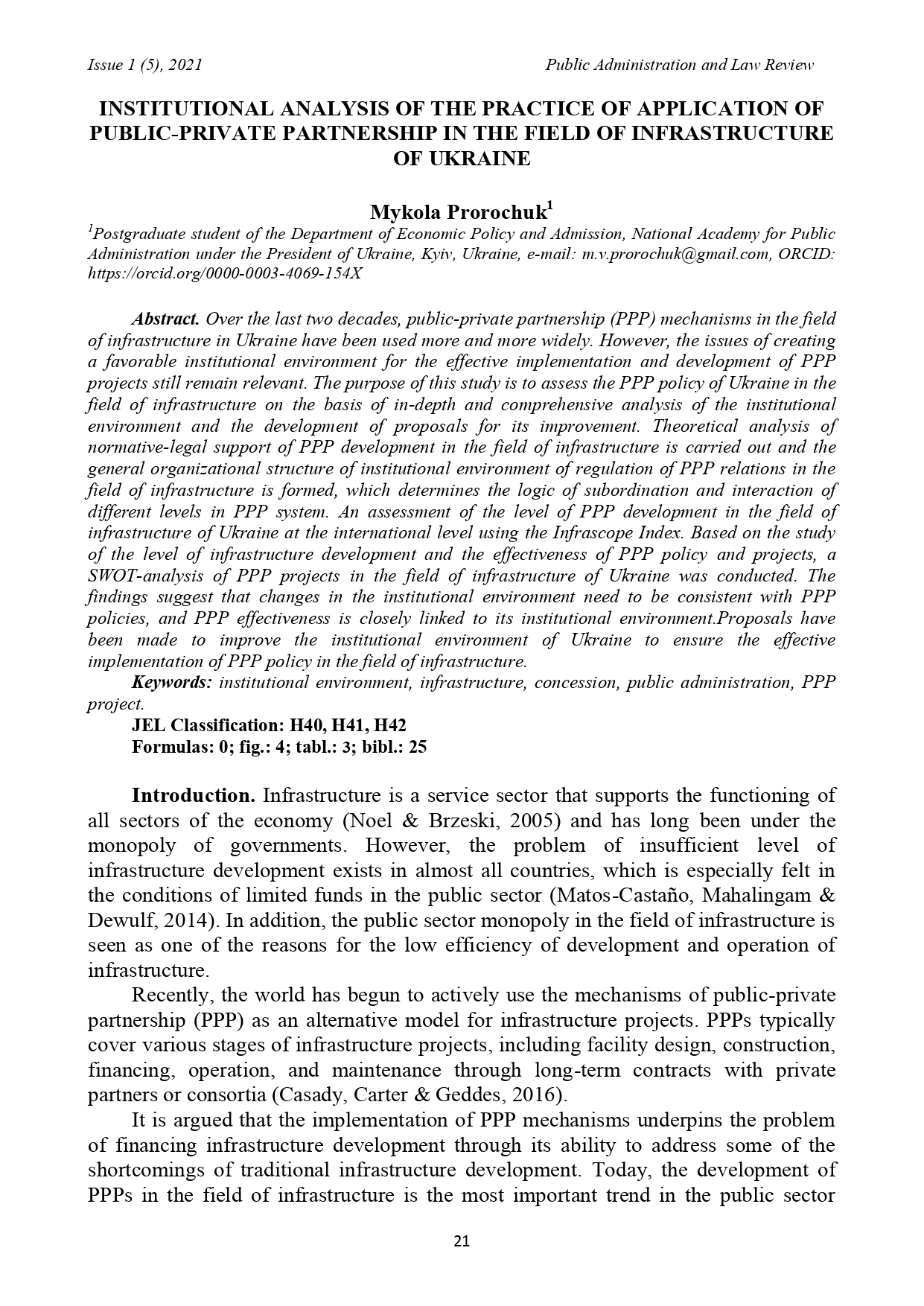INSTITUTIONAL ANALYSIS OF THE PRACTICE OF APPLICATION OF PUBLIC-PRIVATE PARTNERSHIP IN THE FIELD OF INFRASTRUCTURE OF UKRAINE
DOI:
https://doi.org/10.36690/2674-5216-2021-1-36Keywords:
institutional environment, infrastructure, concession, public administration, PPP projectAbstract
Over the last two decades, public-private partnership (PPP) mechanisms in the field of infrastructure in Ukraine have been used more and more widely. However, the issues of creating a favorable institutional environment for the effective implementation and development of PPP projects still remain relevant. The purpose of this study is to assess the PPP policy of Ukraine in the field of infrastructure on the basis of in-depth and comprehensive analysis of the institutional environment and the development of proposals for its improvement. Theoretical analysis of normative-legal support of PPP development in the field of infrastructure is carried out and the general organizational structure of institutional environment of regulation of PPP relations in the field of infrastructure is formed, which determines the logic of subordination and interaction of different levels in PPP system. An assessment of the level of PPP development in the field of infrastructure of Ukraine at the international level using the Infrascope Index. Based on the study of the level of infrastructure development and the effectiveness of PPP policy and projects, a SWOT-analysis of PPP projects in the field of infrastructure of Ukraine was conducted. The findings suggest that changes in the institutional environment need to be consistent with PPP policies, and PPP effectiveness is closely linked to its institutional environment.Proposals have been made to improve the institutional environment of Ukraine to ensure the effective implementation of PPP policy in the field of infrastructure.
Downloads
References
Casady, CB and R. Geddes (2016). Private Participation in US Infrastructure: The Role of PPP Units. Washington, DC: American Enterprise Institute (AEI).
Casady, C. B., Eriksson, K., Levitt, RE & Scott, WR (2019). (Re) Defining Public-Private Partnerships (PPPs) in the New Public Governance (NPG) Paradigm: An Institutional Maturity Perspective. Public Management Review.
Chou, J. & Pramudawardhani, D. (2015). Cross-country comparisons of key drivers, critical success factors and risk allocation for public-private partnership projects. International Journal of Project Management, 33, 1136-1150.
EIU. (2018). Measuring the Enabling Environment for Public-Private Partnerships in Infrastructure. New York, NY: EIU.
EIU. (2019). Evaluating the environment for public-private partnerships in Latin America and the Caribbean: The 2019 Infrascope. New York, NY: EIU.
Garvin, MJ & Bosso, D. (2008). Assessing the effectiveness of public-private partnership programs and projects. Public Works Manag. Policy 13, 162-178.
Hodge, GA, & Greve, C. (2017). On public – private partnership performance: A contemporary review. Public Works Management & Policy 22, no. 1: 55-78.
Li, B., Akintoye, A., Edwards, PJ & Hardcastle, C. (2005). Critical success factors for PPP / PFI projects in the UK construction industry. Constr. Manag. Econ. 23, 459-471.
Matos-Castaño, J., Mahalingam, A. & Dewulf, G., (2014). Unpacking the pathdependent process of institutional change for PPPs. Aust. J. Public Adm. 73 (1), 47-66.
Moszoro, M., Gonzalo A., Fernanda R. & Schwartz, J. (2014). Institutional and Political Determinants of Private Participation in Infrastructure. In Public Private Partnerships for Transport Infrastructure: Renegotiations, How to Approach Them and Economic Outcomes. Washington, DC: ITF Roundtable.
Muhammad, Z. & Johar F. (2017). A Conceptual Framework for Evaluating the Success of Public-Private Partnership (PPP) Projects. Advanced Science Letters 23, no. 9: 9130-9134.
Noel, M. & Brzeski, WJ (2005). Mobilizing private finance for local infrastructure in Europe and Central Asia: An alternative public private partnership framework. World Bank Publications, Washington
Opara, M., Fathi E., Okafor, O. & Warsame H. (2017). Effects of the Institutional Environment on Public-Private Partnership (P3) Projects: Evidence from Canada. Accounting Forum 41, no. 2: 77-95.
Public-Private Infrastructure Advisory Facility (PPIAF) (2016) .The State of PPPs: Infrastructure Public-Private Partnerships in Emerging Markets & Developing Economies 1991-2015. Washington, DC: World Bank.
Soecipto, RM & Verhoest K. (2018). Contract stability in European road infrastructure PPPs: how does governmental PPP support contribute to preventing contract renegotiation? Public Management Review: 1-20.
Ukraine. Verkhovna Rada of Ukraine. Legislation of Ukraine. Retrieved from https://zakon.rada.gov.ua/laws/main/en/index
Ukraine. Ministry for Development of Economy, Trade and Agriculture of Ukraine. International Finance Corporation to Advise Ministry of Economic Development on Public-Private Partnership Support Agency. Retrieved from https://www.me.gov.ua
Ukraine. Ministry of Infrastructure of Ukraine. Retrieved from https://mtu.gov.ua/en/timeline/
Ukraine. National Institute for Strategic Studies. Regarding the development of public-private partnership as a mechanism for intensifying investment activity in Ukraine. Analytical note of the National Institute for Strategic Studies. Retrieved from http://www.№iss.gov.ua/articles/816
Van den H., Brogaard, L., Lember, W., Petersen OH & Witz, P. (2015). National varieties of Public – Private Partnerships (PPPs): A comparative analysis of PPP-supporting units in 19 European countries. Journal of Comparative Policy Analysis: Research and Practice 18, no. 1: 1-20.
Verhoest, K., Carbonara, N., Lember, V., Petersen, OH, Scherrer, W. & Hurk, M. Van den. (2013). Public Private Partnerships in Transport: Trends & Theory P3T3. Discussion Papers part I, COST.
World Bank. Infrastructure Finance, PPPs & Guarantees Database. Retrieved from https://ppi.worldbank.org/en/snapshots/country/ukraine
World Bank (2015). Public-private partnership in the context of public investment management in Ukraine. Rating. Retrieved from https://issuu.com/mineconomdev/docs/zvit_sb_pdf/7
World Bank (2017). Benchmarking Public-Private Partnerships Procurement 2017: Assessing Government Capability to Prepare, Procure, and Manage PPPs. Washington, DC: IBRD / World Bank.
World Bank (2018). Procuring Infrastructure Public-Private Partnerships Report 2018: Assessing Government Capability to Prepare, Procure, and Manage PPPs. Washington, DC: IBRD / World Bank.

Downloads
Published
How to Cite
Issue
Section
License
Copyright (c) 2021 “Scientific Center of Innovative Researches” OÜ

This work is licensed under a Creative Commons Attribution 4.0 International License.





